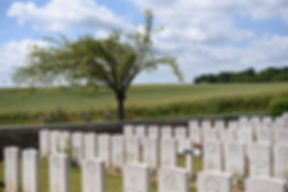


Larch Wood (Railway Cutting) Cemetery
Belgium
2 Old Bristolians
Larch Wood (Railway Cutting) Cemetery (CWGC, 2016)
The cemetery was named after a copse alongside the railway. It was used throughout the war, except for a period of German occupation in 1918, and afterwards for reburials from the battledield. It contains the graves of 700 British soldiers, sailors and airmen and of 86 Canadian, 36 Australian, 1 British West Indian and 33 unidentified soldiers.
The cemetery was begun in April 1915 at the North-end of a small plantation of larches. It was used by troops holding this sector, particularly the 46th (North Midland) Division and the 1st Dorsets, until April 1918. It was enlarged after the Armistice when graves were brought in from the battlefields of Ypres and from a number of smaller cemeteries.
The cemetery contains 856 burials and commemorations of the First World War. 321 of the burials are unidentified and there are special memorials to 82 casualties known or believed to be buried in the cemetery. Other special memorials record the names of five casualties buried in German cemeteries whose graves could not be found on concentration.
The cemetery was designed by Sir Edwin Lutyens.
Casualties
I.B.17
Black was born on 21/10/1897, and attended the School from 1905-1909. He served as a Flight Lieutenant in the RAF, with the Royal Naval Air Service 9th Sqdn.. Black sadly lost his life on 12/10/1917, as a result of the War.
Special Memorial A. 19.
Harding was born on 16/01/1888, and attended the School from 1898-1900. He served as a Gunner in the Army, with the Royal Field Artillery, "D" Bty, 242nd Bde.. Harding sadly lost his life on 22/09/1917, as a result of the War.
Photographs & Site Map
-Cemetery_pn.png)